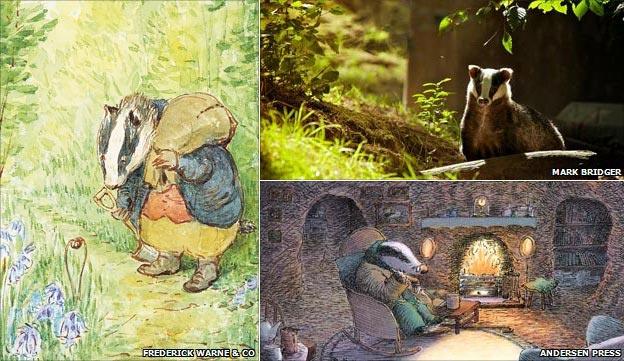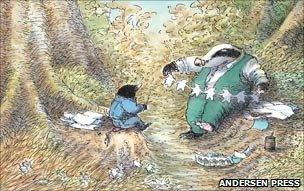Badger cull: Are we silly to be so sentimental?
- Published

Beatrix Potter's odious Tommy Brock (left), and Susan Varley's more sympathetic Badger (lower right)
Few subjects are likely to enrage British wildlife lovers more than the idea of a badger cull - yet it's something the government has been debating this week. Why do people have such a strong attachment to this scarcely-seen creature?
Rabbits, foxes and hedgehogs have their supporters, but the badger has traditionally elicited a unique mixture of fondness and respect.
"No animal enjoys better protection than the badger, though few need it less. Uniquely, it has its own Act of Parliament to defend its wellbeing, yet - unlike hundreds of much more poorly safeguarded species - it is not at all endangered," wrote environmental journalist Geoffrey Lean in the Daily Telegraph earlier this year.
And this despite the evidence that badgers are responsible for infecting cattle with bovine TB.
One proposed solution to stop the spread is a cull of the creature - but this is highly controversial. This week Lord Krebs, author of a 1997 report that led to a randomised badger cull, questioned the effectiveness of widespread killing. In parts of Wales, the rural affairs minister has proposed a new attempt at a badger cull.
But the debate raises a wider question: just why is it that so many of us have a soft spot for the black and white striped digger who spends most of its time hidden underground?
It brings to mind the thoughts of Mole in Kenneth Grahame's The Wind in the Willows:
"The Mole had long wanted to make the acquaintance of the Badger. He seemed, by all accounts, to be such an important personage and, though rarely visible, to make his unseen influence felt by everybody about the place."
Badgers may be a nuisance but the British public loves them regardless, says Jack Reedy, a spokesman for the Badger Trust.
"They occupy an important place in our hearts. Even people whose gardens have been torn apart by badgers have a grudging respect for them."
Some find it hard to resist their striking black and white striped faces, comical gait and playful behaviour.
But there's also the wonder one feels at seeing them emerge from their secret subterranean society and showing what busy, resourceful animals they are, he says. So much so that enthusiasts like Mr Reedy will sit up half the night watching badgers from hides.
"One of them will poke their nose out of the sett, sniff around and go back inside. A few moments later it comes out with the other badgers as if it's told them that the coast is clear."
Once out of the sett, the badgers will roll around, grooming each other with teeth and claws, and in early spring the cubs have play fights, learning to defend their territory.
It would be wrong to call them cute though - badgers have a nasty bite and are the "biggest and best civil engineer" in the animal kingdom, he says.
"Their setts are like a parish - 200 yards of interconnected tunnels crisscrossing an area of 30m by 30m. And each sett will usually have 15 or 16 entrances and seven or eight living chambers."
In this and their housekeeping - changing the straw in the sett every month or so - we can see reflections of ourselves, Mr Reedy says.
Ratty to blame
For the National Farmers Union, this is all rather unfortunate.
"It is an image issue," admits Kevin Pearce, head of food and farming at the NFU. "A lot of farmers like badgers but we also want to control the disease. If your vector spreading TB was a rat, I'm sure that there'd be no problem for farmers in securing a licence to take action."
In New Zealand the TB carrier is the possum, which is considered both a pest and, worse still, Australian. "So the Kiwis have a different attitude and drop poison into wooded areas from helicopters and planes."
Our sentimental attachment to badgers may be a peculiarly British phenomenon. In Ireland culling has been taking place for several years with no public outcry. Because of that, many farmers would prefer if The Wind in the Willows had never been written, Mr Pearce says.
There's no doubt that anthropomorphic characters in animal stories have an effect, says the Times's children's book critic Amanda Craig. And yet, two giants of the genre - Beatrix Potter and Kenneth Grahame - were "very divided" on the subject of badgers.
"Beatrix Potter cast the badger as one of the villains. In The Tale of Mr Tod, the badger and the fox want to catch and eat Peter Rabbit. As a farmer herself she saw these as the two main predators. She's on the side of rabbits and kittens - the small and fluffy v the large and clawed."
In contrast, Grahame's book presented a gruff, ascetic figure who doesn't suffer fools gladly. "Badger hates Society, and invitations, and dinner, and all that sort of thing," Ratty observes.
For book critic Craig he is the fearless moral policeman.
"Mr Badger is completely independent, ancient and lives in the Wild Wood, a place that the other animals are afraid to go. Nothing can stop him, he's the figure of authority, even the weasels and stoats are afraid of him. He's the animal version of God and squire mixed into one."
Craig is used to seeing badgers around her Devon home.
"We often see this enormous black and white bump trundling ahead of us in the headlights - they're utterly fearless. They're one of the largest wild animals left in this country and quite magical."
Unfortunately it's something city dwellers rarely experience as badgers hate noise, she says. Which perhaps explains why they have been eased out of children's literature by an "endless" number of books about foxes - a creature now happily ensconced in the suburbs and inner cities.
But there is one badger story that has caught on in recent decades.

Susan Varley's much-mourned Badger
Susan Varley's Badger's Parting Gifts, first published in 1984, has become something of a favourite at funeral services. Telling the tale of a popular badger who dies and is mourned by his fellow creatures, it seeks to help children cope with the idea of death.
"A badger seemed just right for the story," says Varley. "It's a strong, sturdy looking animal - perfect for the dependable, reliable character who was always willing to lend a helping paw. And their beautiful black and white striped heads were just made for pen and ink."
And yet her badger owes more to human traits than anything observed in the natural world.
"Badger's character has far more to do with my grandmother than a real badger's characteristics," Varley says. "She died shortly before I started the project and a lot of the book is based on the emotions that went along with that."
In short, the badger's purposeful and private way of life offers writers the chance to debate very human concerns.
At a time when the idea of culling or shooting badgers is gaining ground, the animals' supporters must hope that Mr Badger's prediction proves accurate.
"People come - they stay for a while, they flourish, they build - and they go. It is their way. But we remain. There were badgers here, I've been told, long before that same city ever came to be. And now there are badgers here again.
"We are an enduring lot, and we may move out for a time, but we wait, and are patient, and back we come. And so it will ever be."
(Frederick Warne & Co owns all rights, copyrights and trademarks of Beatrix Potter character names and illustrations)